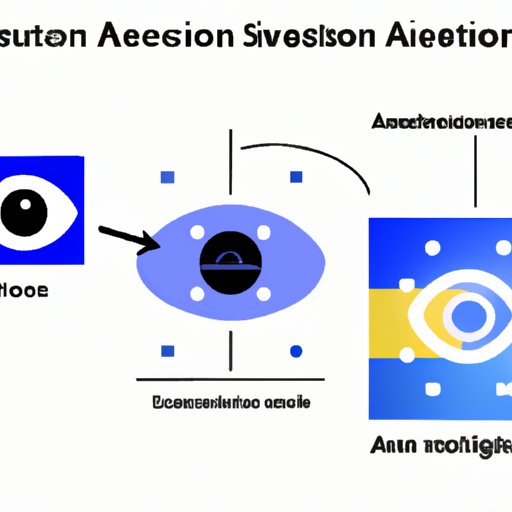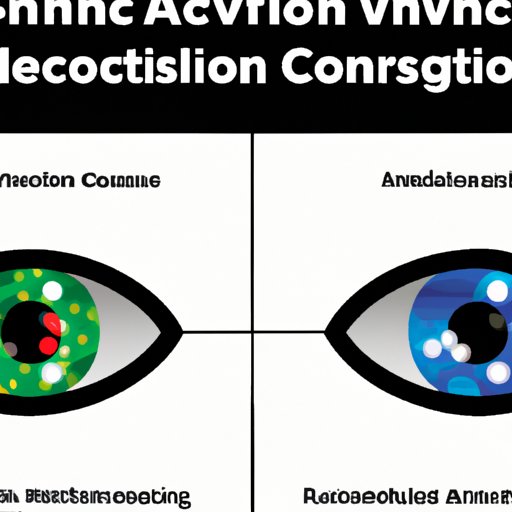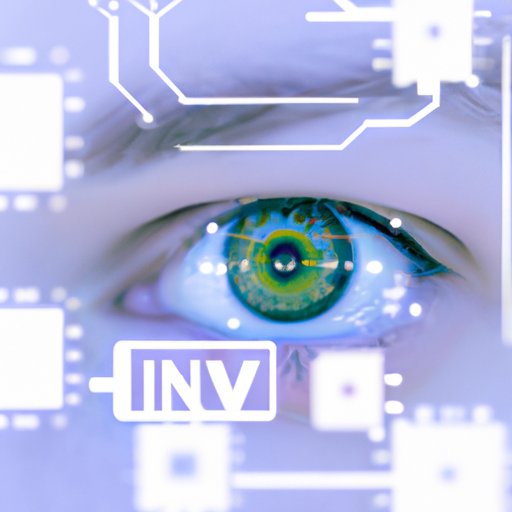Introduction
Computer vision in Artificial Intelligence (AI) is an area of research that focuses on creating systems that can interpret, analyze, and understand visual data from images and videos. It enables machines to recognize objects, people, and other features in digital images or videos. By leveraging the power of AI technologies, computer vision can be used to automate processes and enable more efficient decision-making. This article will explore the basics of computer vision, its applications, and how it is changing the way we interact with AI.

Exploring the Basics of Computer Vision in AI
Computer vision is a subfield of AI that focuses on developing algorithms and models that can process visual information from videos and images. The goal of computer vision is to enable machines to understand and interpret the contents of an image or video, such as recognizing objects, people, and other features. To achieve this, computer vision algorithms are trained using labeled datasets, which are collections of images that have been manually labeled with categories and tags.
There are several types of computer vision algorithms, including supervised learning algorithms, unsupervised learning algorithms, and reinforcement learning algorithms. Supervised learning algorithms are trained on labeled datasets to produce a model that can be used to classify new images. Unsupervised learning algorithms use unlabeled datasets to find patterns and clusters in the data. Reinforcement learning algorithms learn from trial and error, adjusting their behavior based on feedback from the environment.
The key components of computer vision include image processing, feature extraction, object recognition, and model building. Image processing involves transforming raw images into usable data. Feature extraction involves identifying and extracting important features from the image. Object recognition involves applying machine learning algorithms to identify objects in the image. Model building involves training a model on a labeled dataset to create a model that can classify new images.

A Comprehensive Guide to Understanding Computer Vision in AI
Understanding the different types of AI-powered computer vision technologies is essential for leveraging the power of computer vision in AI applications. Some of the most popular computer vision technologies include convolutional neural networks (CNNs), deep learning, transfer learning, and generative adversarial networks (GANs). Each technology has its own set of advantages and disadvantages, so it’s important to understand the pros and cons of each before making a decision.
CNNs are one of the most widely used computer vision technologies. They are used for image classification and object detection tasks. CNNs are able to identify patterns and features in images, making them well suited for tasks such as facial recognition and object detection. Deep learning is another popular computer vision technology. It uses multi-layer neural networks to analyze data and make predictions. Transfer learning is a technique that allows a model to be trained on existing datasets, and GANs are used to generate new images from existing images.
When exploring the benefits and challenges of computer vision in AI, there are several key points to consider. On the plus side, computer vision can improve automation and efficiency by enabling machines to quickly interpret and analyze visual data. It can also improve safety and security by allowing machines to detect potential threats or anomalies. On the downside, computer vision algorithms can be computationally expensive and require large amounts of data to be trained effectively.
An Introduction to Computer Vision Technologies in AI
Computer vision technologies can be used in a variety of ways to improve automation and efficiency. One of the most common applications of computer vision is object recognition, which involves using a model to identify objects in an image or video. Object recognition can be used for tasks such as facial recognition, vehicle identification, and product categorization. Other computer vision technologies can be used for tasks such as image classification, segmentation, and clustering.
Each type of computer vision technology has its own set of pros and cons. For example, CNNs require large datasets to train effectively, but they are very accurate and can be used for a wide range of tasks. Deep learning is computationally intensive, but it offers high accuracy and can be used for complex tasks such as image classification. Transfer learning is less computationally intensive than deep learning, but it requires labeled datasets to train effectively. GANs are relatively efficient and can be used to generate new images from existing images.
How Computer Vision is Changing the Way We Interact with AI
Computer vision is becoming increasingly important as AI technologies become more prevalent in our lives. By enabling machines to interpret and analyze visual data, computer vision can help improve automation and efficiency. For example, computer vision can be used to automate tasks such as facial recognition, object detection, and product categorization. This can reduce the amount of time and effort required to complete these tasks, improving overall efficiency.
Computer vision can also improve security and safety. By allowing machines to detect potential threats or anomalies, computer vision can help ensure that people and businesses remain safe. For example, computer vision can be used to monitor security cameras or detect suspicious activity. Additionally, computer vision can be used to detect objects in hazardous environments, such as mines or nuclear power plants, making them safer for workers.

Uncovering the Potential of Computer Vision in AI
The emergence of new technologies is helping to expand the use cases for computer vision in AI. For example, autonomous vehicles rely heavily on computer vision to navigate their environment. Additionally, augmented reality and virtual reality applications are beginning to leverage computer vision to create more immersive experiences. As these technologies continue to evolve, the use cases for computer vision will only continue to increase.
At the same time, computer vision is being used to develop new applications that were not previously possible. For example, computer vision is being used to develop medical diagnostics tools that can detect diseases and medical conditions. Additionally, computer vision is being used to develop tools that can detect signs of human trafficking or locate missing persons.
Conclusion
Computer vision is a powerful tool in the world of artificial intelligence, allowing for automation, improved security, and greater efficiency. By leveraging the power of AI technologies, computer vision can be used to automate processes and enable more efficient decision-making. Additionally, computer vision technologies are continuing to evolve, opening up new possibilities for AI applications. The potential for computer vision in AI is immense, and its impact on the future of AI is sure to be significant.
(Note: Is this article not meeting your expectations? Do you have knowledge or insights to share? Unlock new opportunities and expand your reach by joining our authors team. Click Registration to join us and share your expertise with our readers.)
